Micromobility is here to stay, and it’s changing how we experience urban life for the better. With Unagi’s membership program, you can enjoy all the benefits of a top-tier electric scooter without the sky-high price of ownership or the inconvenience of ride-sharing.
Thinking about exploring Chicago on a lightweight electric scooter.
Chicago's electric scooter scene has been on a roll since the pilot program to integrate e-scooters into its landscape kicked off in 2019. Fast forward a few years, and Chicago has its very own city-owned shared scooter company, which showcases a well-developed scooter-sharing scheme backed by solid infrastructure.
This infrastructure includes over 420 miles of protected bike lanes and trails crisscrossing Chicago and Evanston. This extensive network provides riders with ample opportunities to discover the city's offerings, from impressive skyscrapers to serene parks and the inviting public beaches along the shores of Lake Michigan.
To ensure the safety of all road users and facilitate the smooth integration of scooters into the public transportation ecosystem, the City has also implemented a clear set of rules governing shared scooter operations, which every rider needs to be acquainted with to ride responsibly.
In the following sections, we'll take a deep dive into the electric scooter laws in Chicago, covering every essential rule. We'll also highlight some of the most scenic routes and must-visit places when exploring the city on an e-scooter. Finally, we'll conclude with valuable advice on how to ride safely within the City of Chicago.
Are electric scooters allowed in Chicago?
Yes, electric scooters are welcome in most areas of Chicago, with a few exceptions in trails and parks that restrict motorized vehicles. The proof is in the numbers: from May 2022 till February 9, 2024, the city has seen over 3.8 million scooter trips, showcasing their widespread acceptance and popularity. And that’s just for shared scooters, not even including the countless private rides that have likely occurred during the same period.
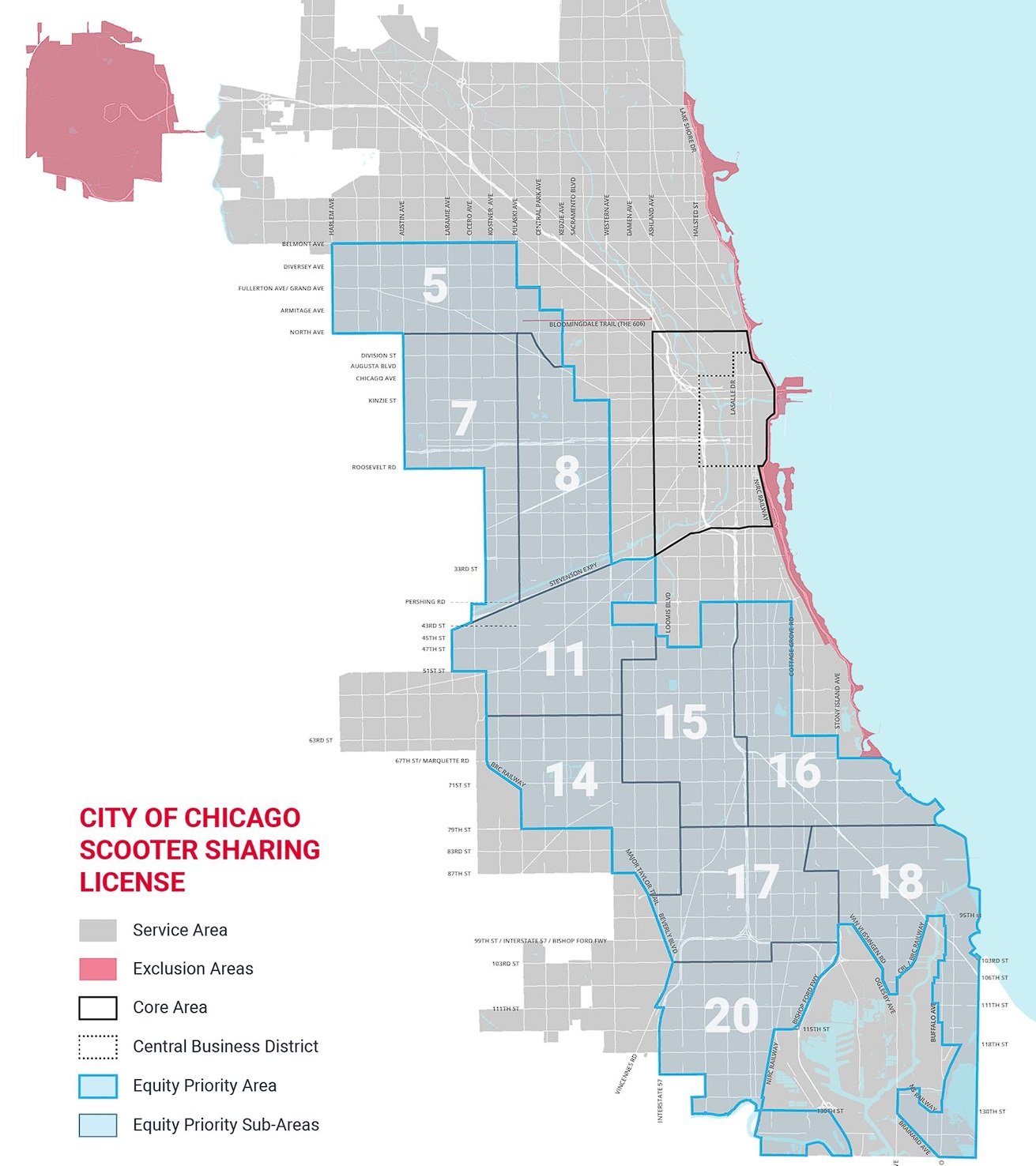
For shared scooters, Chicago has clearly mapped out specific zones where riding is permitted. These zones are the Service Areas, shaded in gray, which include the Equity Priority Areas (highlighted in blue) and the Central Business District (defined with black and dotted outlines).
Exclusion Zones (marked in pink) are off-limits for any shared electric scooters.
What are the current laws governing electric scooters in Chicago?
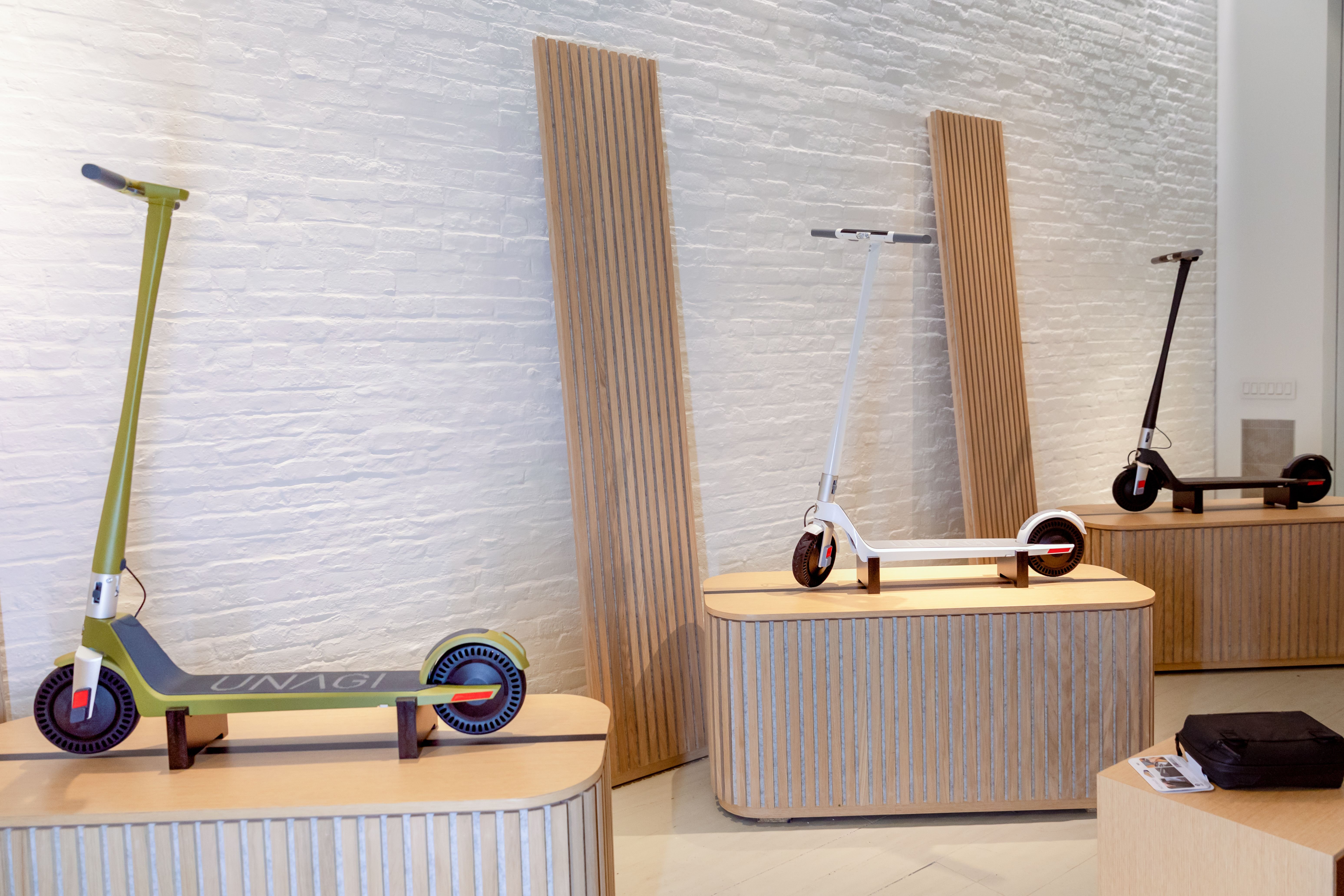
The current rules governing the use of electric scooters in Chicago were signed on June 14, 2023, but they primarily focus on shared electric scooters. Unfortunately, private electric scooters still linger in a gray area with no specific mentions in city ordinances. On a state level, a bill has been proposed to regulate all electric scooters, but it has not been passed as of this writing.
So, where does that leave private scooter riders?
Without clear rules, riders can borrow some guidelines from the shared scooter regulations. Also, in general, electric scooter riders are expected to follow the same rules, regulations, and local laws as bicyclists, which include things like following traffic signs and lights, yielding to pedestrians, signaling when turning, riding in the same direction as traffic, not riding on sidewalks, etc.
So, while the laws are still catching up, the best practice is to adhere to the established shared electric scooter laws and mix them with bicycle laws to stay safe and avoid any potential fines or issues.
Do you need a license to ride an e-scooter in Chicago?
As it stands right now, you don't need a license to ride an e-scooter in Chicago.
However, on the state level, there’s a proposed bill floating around that aims to change this. If passed, it would require riders to have a valid driver's license, instruction permit, or state ID card to legally operate an electric scooter.
What is the minimum age for e-scooter riders in Chicago?
The minimum age to hop on an e-scooter is 16 years old. However, if you’re 16 or 17, you’ll still need parental or guardian consent to ride a shared electric scooter. So, realistically, the minimum age to ride without jumping through hoops is 18.
Helmet requirements for e-scooter riders in Chicago

Wearing a helmet while riding an electric scooter isn’t mandatory, but it’s highly recommended for safety. Electric scooter-sharing companies are encouraged to strongly advise their customers to wear helmets while using their services, and for good reason.
During the 2019 and 2020 e-scooter pilot programs in Chicago, hospitals reported 0.2 e-scooter-related injuries per 100,000 rides. The numbers seem low, yes, but they exclude small falls and accidents that could have been more severe without proper gear. Therefore, strap on your helmet to lessen your chances of making that trip to the hospital.
Can you carry a passenger or items on an electric scooter in Chicago?
Doubling up or carrying large items on an electric scooter in Chicago is strictly prohibited. Scooters are designed for single riders, and overloading them can be both dangerous and illegal.
For more information on this topic, please refer to our article: "Can You Carry a Passenger on an Electric Scooter?"
Insurance and registration requirements for electric scooters in Chicago
Electric scooter riders are not legally required to have liability insurance, nor do they need to register their scooters with the DMV.
Legal requirements for electric scooters in Chicago

There are no specific rules for privately owned electric scooters. However, if the shared scooter specs are anything to go by, here’s what you’ll probably need to ensure to remain in compliance in the future:
- No operable pedals: If your scooter has pedals, it might be classified as a bike, which comes with different rules.
- Maximum width and weight: Scooters should be no wider than 26 inches and weigh under 100 pounds.
- Speed limit: The electric motor should not exceed a top speed of 15 mph.
- Safety features: If you’re riding at night, your scooter must have front and rear lights. A proper braking system (both front and rear) is essential for safe stops. Don’t forget a bell or horn for alerting other users—just make sure it’s not a siren.
Where can you legally ride electric scooters in Chicago?
When it comes to finding a place to ride your electric scooter in Chicago, think bike-friendly areas. You can ride anywhere bicycles are permitted, which means your primary zones will be on bike lanes, shared lanes, and bike paths. These lanes are clearly marked, making them the safest spots to ride.
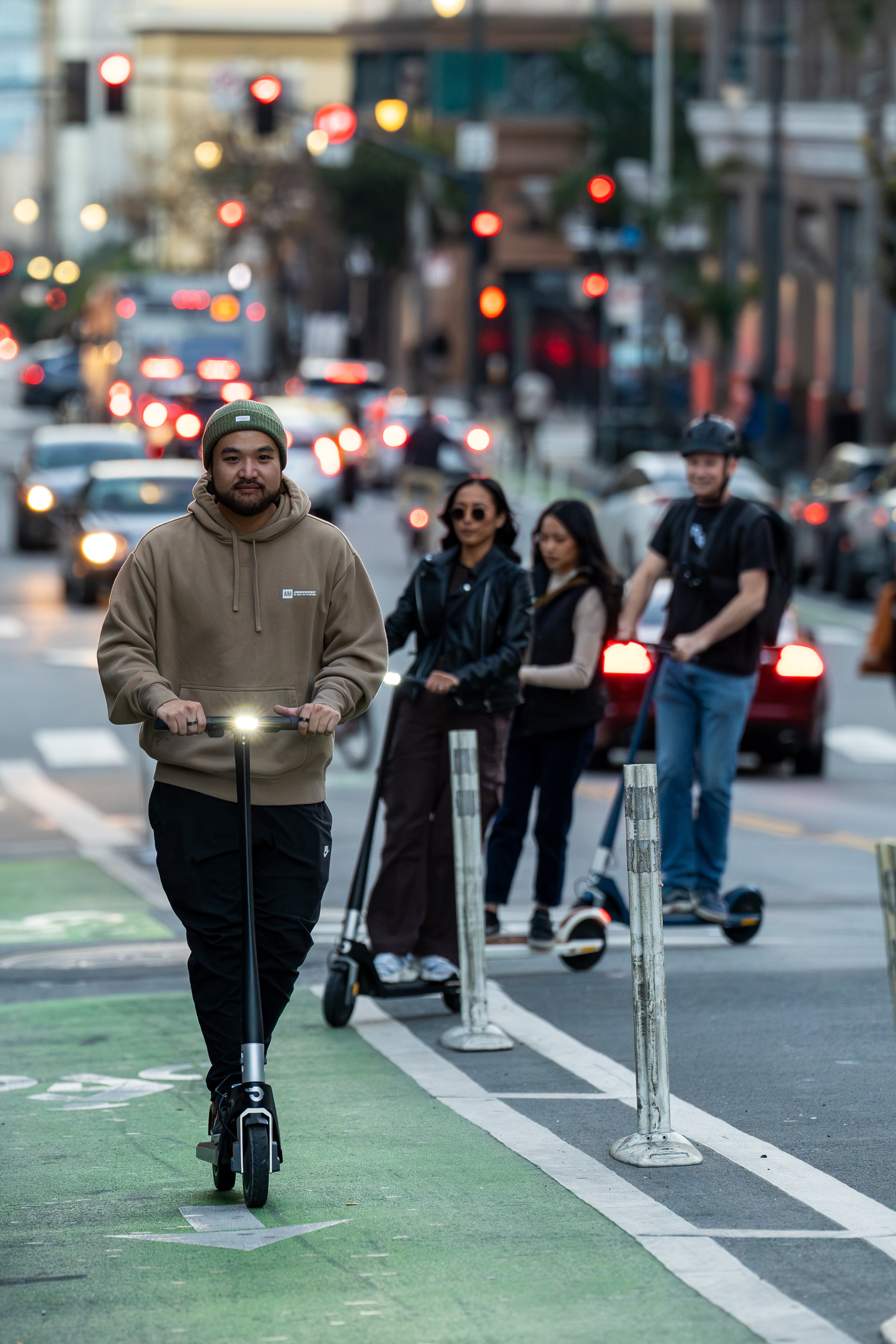
To further protect riders, the local authorities are installing concrete curbs as a standard barrier for all new protected bike lanes. These barriers clearly separate vehicle lanes from bike lanes, eliminating confusion about where cars should park and drive and improving the safety of all users on the bike lanes.
If there’s no bike path available, you’re allowed to ride on Chicago streets; just stick to the right side and keep a safe distance from traffic.
But remember: some areas that allow bicycles might ban motorized vehicles like scooters, so always stay alert for signs.
Where are electric scooters prohibited in Chicago?
To maintain order and safety, electric scooters are not allowed in certain areas of the city. These areas include sidewalks, certain parks and beaches, some university grounds, and trails. These spots tend to be crowded, and the use of electric scooters could increase the chances of pedestrian accidents.
This ban specifically applies to shared electric scooters, and privately owned scooters are still in a gray area regarding their use in these locations. However, some restrictions are still justified, like riding on the sidewalk, which is generally not allowed even for bicycles, so it will automatically apply to private scooters as well.
Here are the exact areas where shared electric scooters are banned and where private scooters should also exercise caution:
- The Lakefront Trail (and all areas east of the trail)
- The 606 (Bloomingdale Trail)
- The Chicago Riverwalk
- O'Hare Airport
Some universities have requested a ban on shared electric scooters on their turf, including:
- University of Chicago
- Northwestern University's downtown campus
- North Park University
- DePaul University
However, electric scooters can still be used on a public right-of-way that goes through these campuses.
Luckily, most shared scooter apps will have an updated list of areas where their electric scooters are not allowed and will also have geofencing technology that alerts or prevents you from venturing into these exclusion zones.
Is it legal to ride electric scooters on sidewalks in Chicago?

Sidewalk riding in Chicago is a big no-no for electric scooters, except for brief moments when parking or starting your ride. Note that even in these instances, pedestrians still have the right of way, and you need to push your scooter rather than ride it.
Shared electric scooters come equipped with sidewalk-riding detection hardware and software. This technology can warn riders, slow down, or even stop the scooter if it detects sidewalk riding. The city is strict on this rule, so even if you have a private scooter, it's best to avoid riding on sidewalks to dodge fines and prevent accidents.
Can you ride an electric scooter on the road in Chicago?
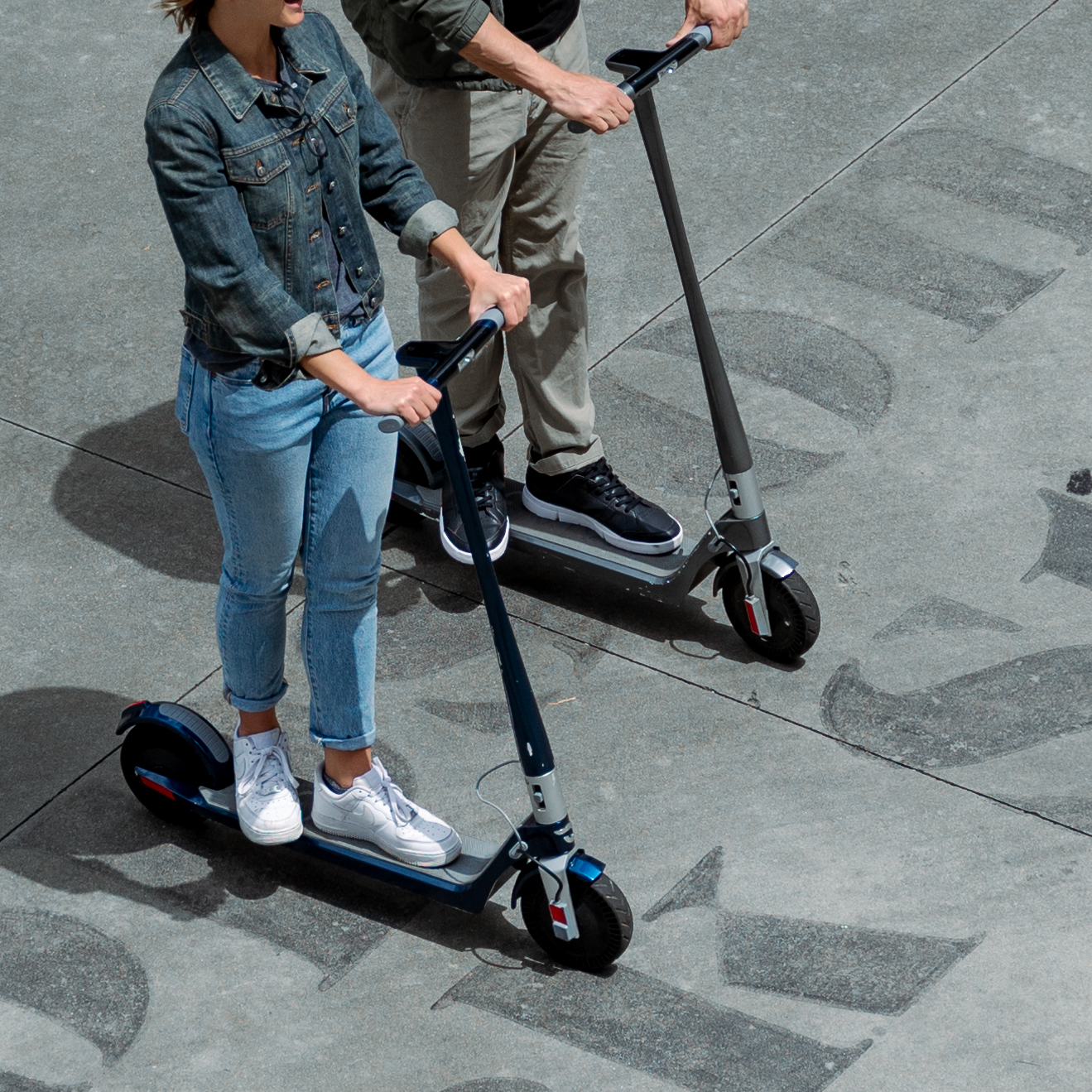
Yes, you can ride electric scooters on the road in Chicago, but only if there are no bike lanes available. In these situations, e-scooters need to stick to the right side of the road to let cars pass safely. Riders also have to follow the traffic rules set out in the Illinois vehicle code.
If the current bill passes, electric scooters will be prohibited on state highways, expressways, or roads with a speed limit over 35 mph. But honestly, why risk riding on such fast vehicle lanes on an electric scooter?
For more details on how to ride safely on the road and the laws involved, check out our article on riding electric scooters on the road.
What is the speed limit for electric scooters in Chicago?
The current speed limit for shared electric scooters in Chicago is 15 mph. For first-time users, the speed limit is even lower at 10 mph to ensure new riders get accustomed to the scooter's controls and handling before reaching higher speeds.
If the current electric scooter bill passes in the Senate, there will also be a maximum speed limit set for privately owned electric scooters at 20 mph.
Where should you park your electric scooter in Chicago?
Always use designated scooter parking areas (e.g., divvy docking station), bike racks, or the furniture zone of the sidewalk. Ensure you're not blocking traffic on the sidewalk or roadways.
Make sure your scooter is parked upright, which keeps it tidy, takes up less space, and avoids becoming a tripping hazard. To avoid these hassles and complications, if you own an electric scooter, consider buying a scooter bag and carrying your scooter with you when entering different premises. It's practically safer than leaving it unattended outside.
The rules are stricter for shared electric scooters. You are required to park at the designated electric scooter sharing dock or lock the scooter to an approved fixed object, like a bike rack or light pole, using the lock provided by the company. Note that this second option may incur an additional fee (e.g., Divvy charges an additional $2.40 for non-members for parking in such locations).
What areas should you avoid when parking your e-scooter in Chicago?
Avoid parking in the following areas to ensure safety and accessibility for everyone:
- Sidewalks and walkways (in a manner that may block traffic)
- Bus shelters or stops
- Loading zones
- Alleyways, doorways, driveways, or accessibility ramps
- Private property and fences
- Fire hydrants
- Emergency services access points.
To curb bad parking practices, the city allows citizens to report parking violations via 311. If a scooter is found to be parked illegally, the scooter-sharing company has a two-hour window to remedy any parking complaints within its normal operating hours.
What are the different ways to access electric scooters in Chicago?
Here's a rundown of how you can get your hands on an electric scooter in the Windy City, whether for day use or a longer period:
Electric scooter rental options in Chicago: One-off use
Chicago has a well-established network of shared electric scooters, meaning you can find them almost anywhere in the city, including the downtown area. These services are offered mainly by three scooter companies: Divvy, Lime, and Spin. There was a fourth company, Superpedestrian, which had 12.5% of the rental scooter market in Chicago but closed shop and has subsequently also shut down its US-based shared scooter operation. The company cited two main reasons for its decision: intense competition in the market and the city's "special relationship" with Lyft (which runs Divvy), which saw its scooters getting a chunk of its operation in high-volume areas (core zones).
Here's a closer look at the different rental companies in operation in Chicago.
Divvy
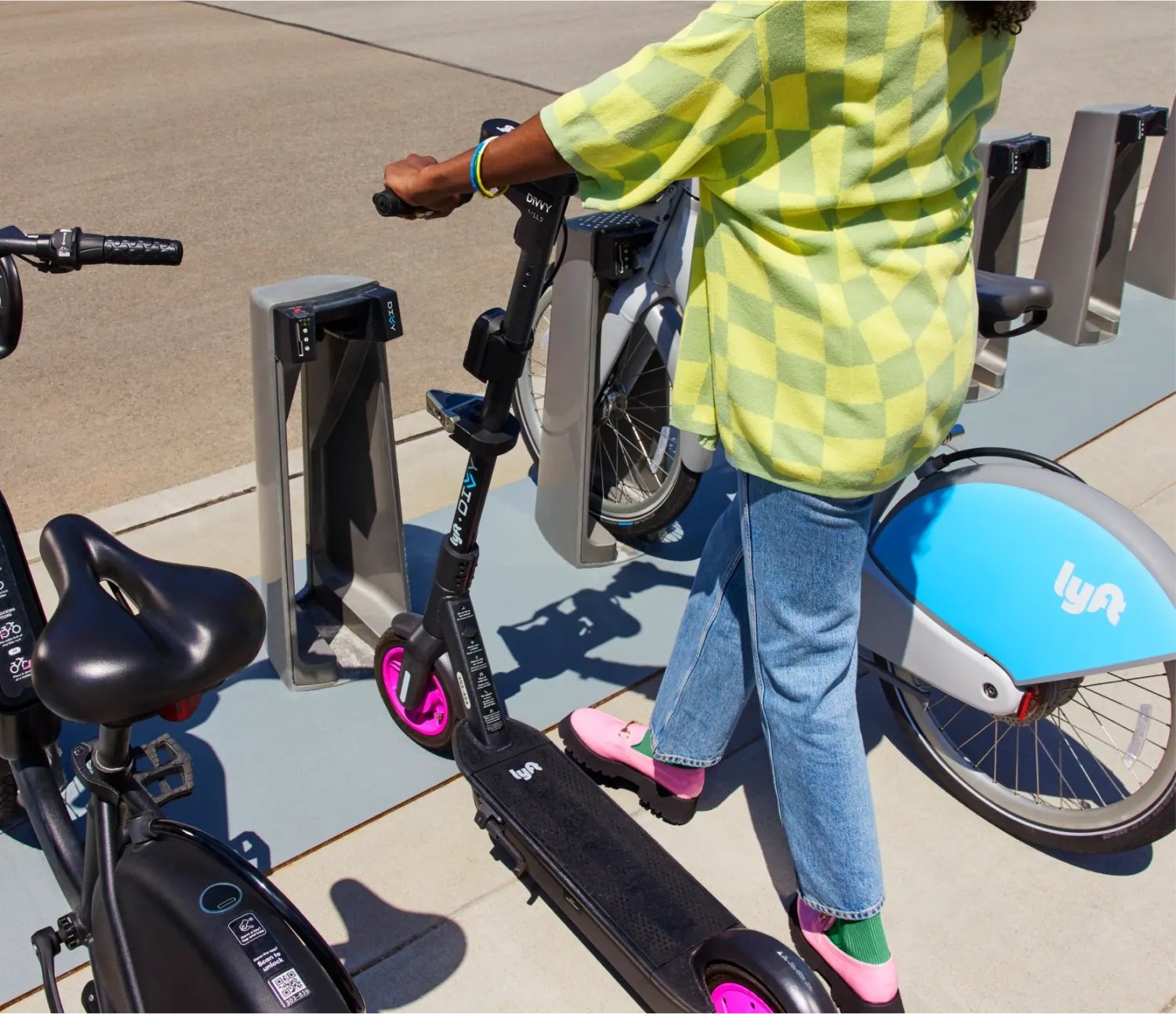
The City of Chicago owns the Divvy system, including the bikes, scooters, and docking stations, while Lyft manages its day-to-day operations and maintenance under a contract. Their divvy bikes are the ones that are most well-known and are all over Chicago, but they have also included electric scooters in their fleet. However, these are limited to the vicinity of downtown Chicago, bounded by DuSable Lake Shore Dr to the east, Pershing Rd. to the south, Damen Ave. to the west, and Armitage Ave. to the north.
Divvy has a significant presence in the downtown area, where a large portion of scooter rides begin and end. Other sharing companies are limited to having only 5% of their scooters in the Core Area and CBD, so Divvy scooters are the ones you will mostly see and use in this area.
You can recognize their scooters by their gray color with pink wheels, and the newer, safer versions feature a blue fender. Their scooters are well-maintained and come equipped with turn signals, a phone holder, and geofencing technology that automatically turns off the power on sidewalks and outside the permitted zone. Once a rider completes a ride, they must park the scooter at the divvy stations to avoid extra fees.
Divvy has the most expensive rates among the providers, with a base rate of $1 to unlock, followed by 44 cents per minute. To get them at a relatively cheaper price, take advantage of available deals, especially for Divvy members and those with income-qualified memberships.
Lime
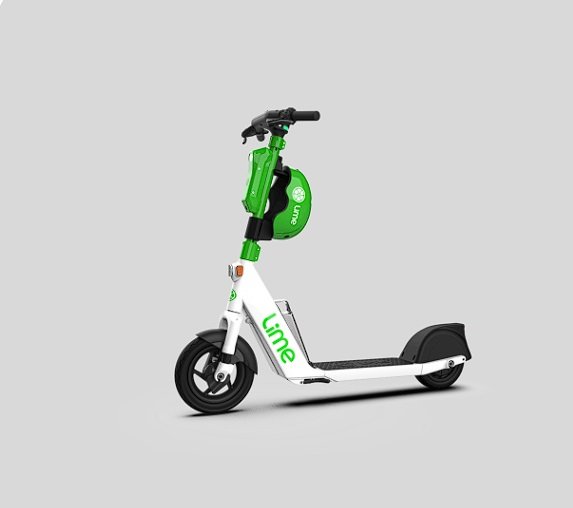
Source: Lime
Lime scooters are recognizable by their green and white color scheme and are available throughout the city, unlike Divvy scooters, which are zone-limited. The scooter unlocking process is relatively easy, and since Lime has a partnership with Uber, you can request them using the Uber app without the need to download the Lime app. The cost of the ride is a base rate of $1 to start, followed by 39 cents per minute.
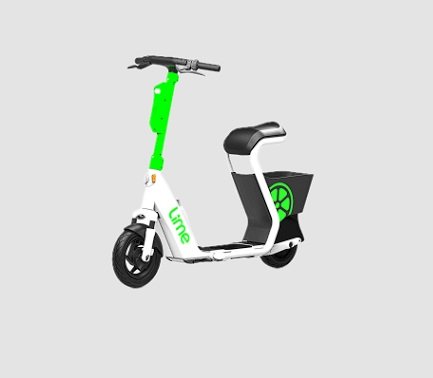
Source: Lime
Lime has also introduced the new Gen4 seated e-scooter, which comes with a seat, larger wheels, and a storage compartment, making them more comfortable and appealing to people with reduced physical mobility.
Spin
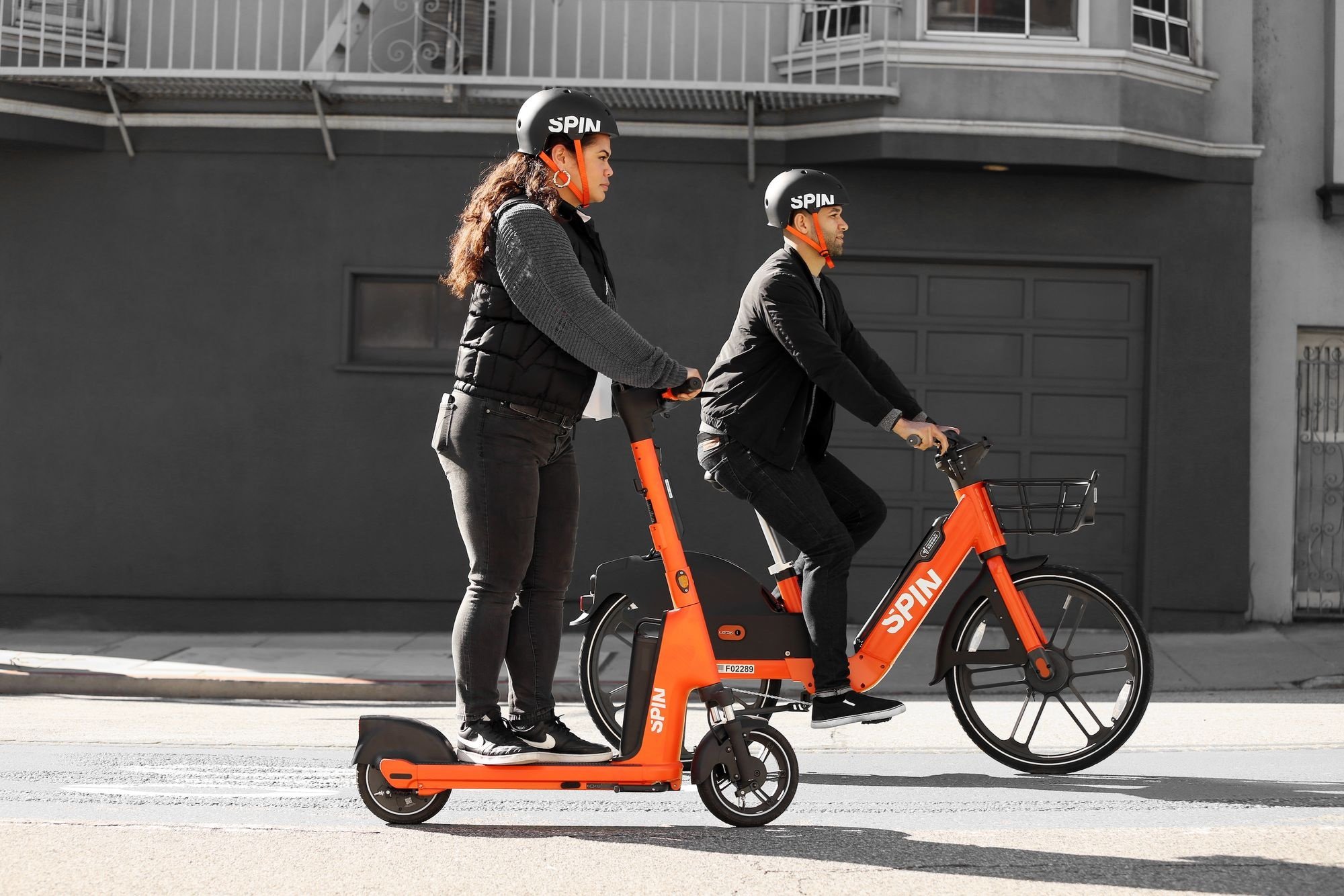
Source: Spin
Spin scooters are also available throughout the city and are distinguished by their orange and black color scheme. They offer a decent ride, similar to all the other rental scooters. You need to have the Spin app to access them, but the whole process is simple. The charges for renting a Spin scooter include an unlock fee of $1 to start, followed by 39 cents per minute.
How much does it cost to rent an electric scooter in Chicago?
Prices can vary depending on the company. Here's a quick breakdown of the single-ride rates:
- Divvy: It costs $1 to unlock a Divvy scooter, followed by 44 cents per minute.
- Lime: A bit more wallet-friendly, Lime scooters cost $1 to start and 39 cents per minute.
- Spin: Spin scooters also have a $1 unlock fee, with a rate of 39 cents per minute.
Now, if you're thinking about frequent rides, consider looking into day passes, monthly plans, or annual memberships that these service providers offer. These deals can shave off a good chunk of change compared to paying per ride.
How do you rent an electric scooter in Chicago?
Electric scooter rental in Chicago is relatively straightforward and will only take a minute.
- Locate a scooter: Riders can find an available scooter using the operator's smartphone app, website, or by contacting customer service. Download the app for the respective scooter-sharing company and register. If you don't have a smartphone, you can access the scooters by paying for the access programs, visiting the physical shops, or text message-based requests offered by the companies.
- First-time riders: Riders must successfully complete a scooter safety quiz that covers rules of the road, safety, parking, sidewalk riding, places where you are not allowed to ride, helmet use, etc.
- Unlock the scooter: Use the app to scan the QR code on the scooter.
- Ride to your destination.
- Park the scooter properly: Upon reaching your destination, park the scooter in accordance with the operator's guidelines and local regulations.
- End the trip: After properly parking and locking the scooter, end your trip using the app.
What are the operating hours for renting electric scooters?
Initially, electric scooters in Chicago could only operate between 5 AM and midnight. However, city officials recently passed an ordinance lifting the ban on e-scooter rides between midnight and 5 AM, meaning rides will soon be available 24/7.
The rollout of these extended hours will depend on program rules set to take effect in June 2024, so it might not be immediately possible to rent and ride e-scooters during those late-night hours just yet.
This move aims to help essential workers, like those in city hospitals, who need to commute during unconventional hours. And while this is great for convenience, it does bring up safety concerns. Riding at night is inherently riskier due to lower visibility, the potential for reckless riding, and the possibility of encountering intoxicated riders.
Electric scooter subscription in Chicago: Ideal for longer-term needs

While there are plenty of rental scooters in Chicago, snagging one in hot zones like the CBD can feel like winning the lottery. Not only that, but rental electric scooters have geofencing and are not permitted in some areas, adding to the inconvenience. And let's not forget, you can't take a shared electric scooter on CTA trains and buses; only personal ones are accepted. This means you can't effectively use these scooters in your day-to-day commutes if they involve these modes of transport. All these disadvantages add to the existing problems you might face with the sometimes half-charged states, dodgy maintenance of the scooters, not to mention hygiene issues, and parking headaches.
Pro Tip: When taking your scooter on the bus, don't bother with the bike rack—it won't fit. If your scooter folds, collapse it and keep it close to you if space allows. You might also encounter some problems with some drivers not allowing scooters on the bus, so you can get an electric scooter bag to disguise it and make it less obvious. In the same breath, this will also make the whole process simpler.
If you want a scooter at your disposal without shelling out for a new one, subscription programs are the way to go. With a subscription, you get your own scooter for a set period, meaning you’re not at the mercy of rental availability. You'll be the sole rider, making maintenance easier and the experience more hygienic (no more wondering about the last person who rode it). You can carry it on any mode of transport, so it will be great as a last-mile commuter scooter. You don't have to worry about parking; you can just carry it wherever you're going.
And the best part? You can ride it pretty much anywhere, as long as it's legal, of course.
Plus, you don't have to rush against the clock every time to try to bring your cost down, as with rental scooters; you can just take your sweet time on the rides.
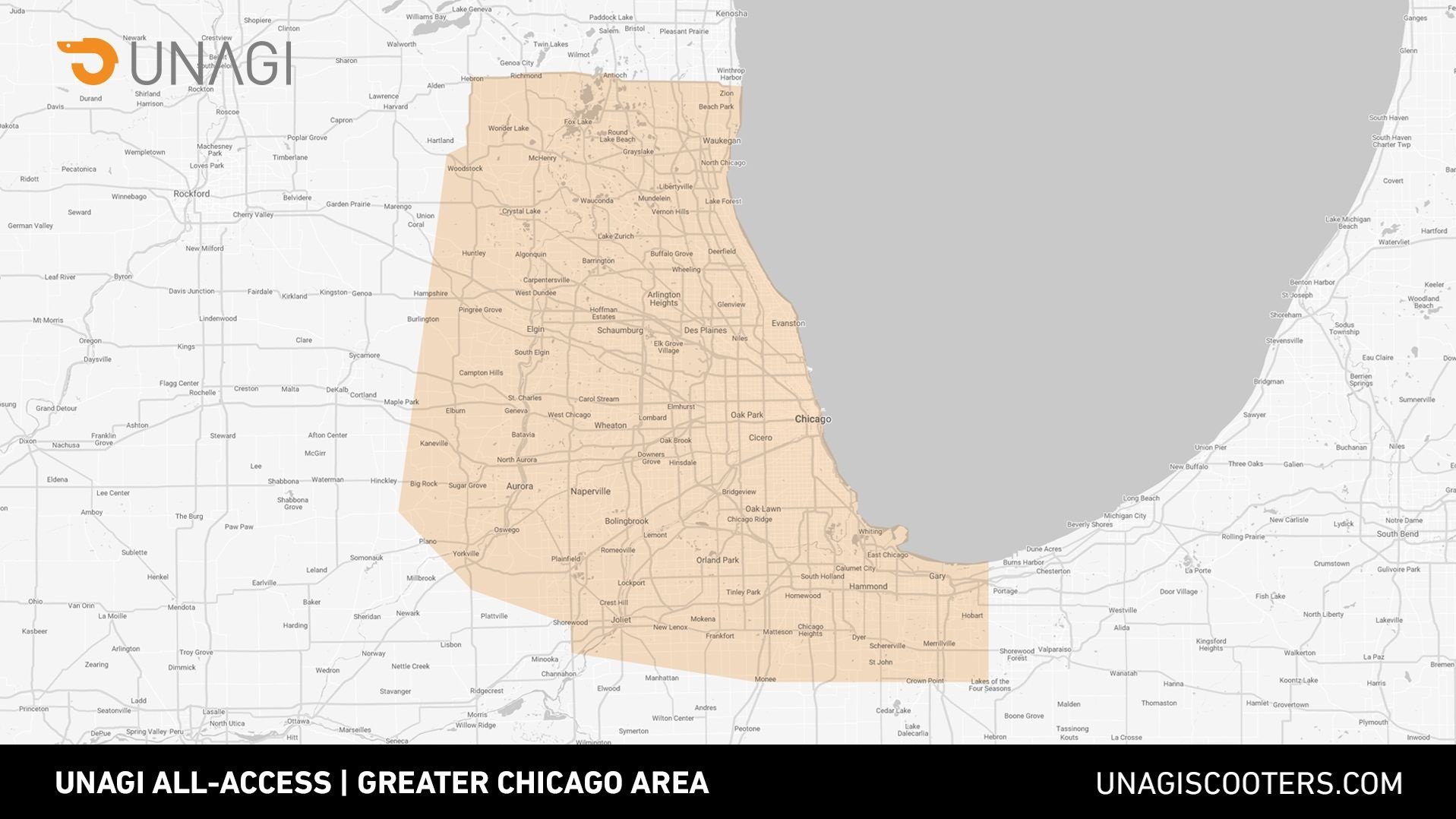
UNAGI has one such "All-Access" subscription program in Chicago. This program covers the entire city and extends to much of the Chicagoland region, including Aurora, Joliet, Naperville, Elgin, Cicero, Arlington Heights, Evanston, and parts of Cook, DuPage, Joliet, Kane, McHenry, and Will Counties.
With the subscription, you get access to UNAGI's lightweight electric scooters, the Model One Classic and the Voyager. Both of these are really sweet rides; first off, they're very stylish, low in weight (both weighing less than 30 lbs.), and very portable, meaning you can carry them easily wherever you go. Performance-wise, they blow rental scooters out of the water. With dual motors, they handle hills like champs and hit top speeds of 20 mph, which you can cap using the Unagi Connect app to suit your preference or the city's speed limits.
For range, you get around 12–25 miles from the UL-certified LG batteries, which is sufficient for your daily commute. Even if you run out of charge, the charging hours are relatively fast at 3–4 hours, so you're quickly back on the road.
Pricing is $59 per month for the Model One Classic and $79 for the Voyager. That's just $1.94 per day for the Classic and $2.59 per day for the Voyager—ridiculously cheap and like the cost of a 5-minute single-day ride with a rental scooter. The more months you subscribe to, the cheaper it becomes, saving you even more money. You also get a lower subscription plan for students, so check that out too.
The Voyager is the updated version of the Model One and has more power and range, hence the difference in pricing.
With that low price, you get a subscription that also includes maintenance. If your scooter breaks down, you get a replacement immediately, so there's no downtime. You also get insurance for scooter theft or damage. To top it off, you get your lightweight electric scooter delivered to your door via FedEx within 72 hours, free of charge. And once you're done with the scooter, you can just unsubscribe--cancel at any time, with no penalty, no hassle, and no commitments.
Buying an electric scooter in Chicago: For the committed rider
If you're all-in on electric scooters and want to dodge those daily or monthly charges, buying your own is a solid long-term move. Rental costs can add up quickly, and before you know it, you might have spent enough to buy one outright. Several shops in Chicago sell electric scooters, including Unagi, which offers both subscription and purchase options. The Unagi Model One Classic goes for $990, and the Voyager for $1,490.
Scenic electric scooter routes in Chicago
Here are some of the most scenic routes to consider:
Lakefront Trail
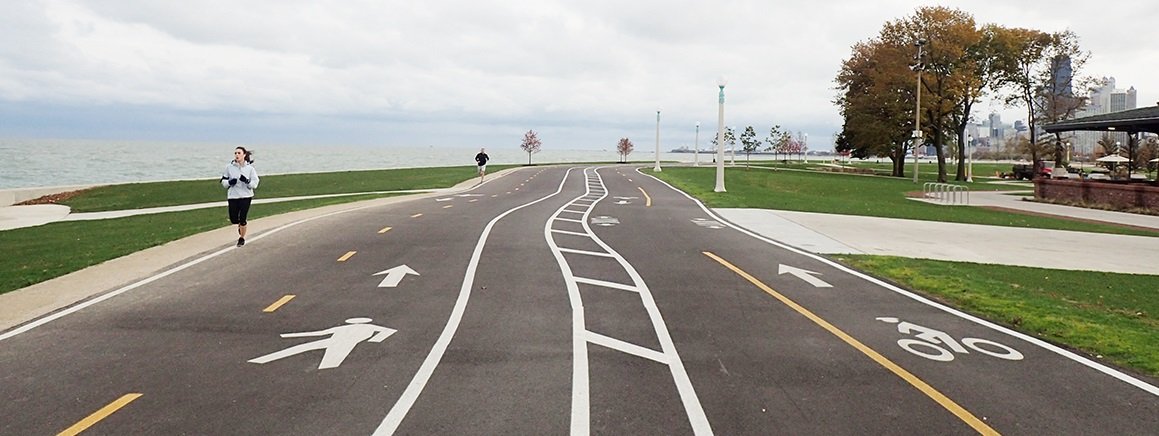
Source: Chicagoparkdistrict
The Lakefront Trail is one of the main trails in Chicago and a must-visit for electric scooter enthusiasts. This 18-mile car-free, fully paved path along the shore of Lake Michigan provides breathtaking views of the lake, beaches, and city skyline. Most of the major parks and beaches in Chicago are either along or close to this area, making it the first trail you'll want to explore.
This scenic route runs from Ardmore Avenue on the north side to 71st Street on the south side, passing through several popular destinations, including Grant Park, Lincoln Park, Burnham Park, North Avenue Beach, and Fullerton Beach.
The trail is easily accessible from various points in the city, with multiple entry points and dedicated paths for cyclists and pedestrians, providing a safe, designated route away from heavy traffic.
While the lakefront can get crowded, there is a clear separation between the bike lane and the walking lane, making it easier to navigate. To beat the congestion on the trail, consider riding early in the morning (around 6 AM to 7:30 AM) or in the evenings after sunset. Watch out for particularly crowded spots, especially on weekends around noon, such as the areas around Fullerton and North Avenue Beaches, South Lakeshore Drive, and the stretch from Irving Park to Grand Avenue.
Chicago Riverwalk
The Chicago Riverwalk stretches for 1.25 miles along the south bank of the Chicago River, from Lake Michigan to Lake Street. This route offers views of the river and iconic architecture, with access to various attractions such as restaurants, bars, and public art installations. One of the main highlights of the Chicago Riverwalk is the beautiful Chicago River itself, which serves as a backdrop for your journey. Along the way, you'll encounter several notable points of interest:
- River Theater: is a public gathering area with terraced seating and a sloped walkway that provides comfortable seating with excellent views of the river and the streetscape above.
- Vietnam Veterans Memorial Plaza: This beautifully designed space is dedicated to honoring the sacrifices of Vietnam War veterans.
- Wrigley Building: A historic landmark known for its stunning architecture and white terra cotta facade.
- Marina City: Famous for its corncob-like twin towers,
- Chicago Architecture Center: Access to museums and cultural attractions that offer rich insights into the city's architectural heritage. Unfortunately, however, you'll need to push your electric scooter while on the path.
Grant Park and Millennium Park
Along the Lakefront trail. This park has several popular attractions, including the magnificent Buckingham Fountain. The fountain puts on a mesmerizing water show every hour. As dusk falls, the show becomes even more enchanting with the addition of lights and music. This area provides a perfect opportunity to capture a breathtaking photo of the Chicago skyline, with the Buckingham Fountain in the foreground and the towering skyscrapers of the city serving as a backdrop.
Another gem within Grant Park is the Art Institute of Chicago, renowned for its extensive and diverse art collection. The museum houses famous works by legendary artists such as Monet, van Gogh, and Seurat. The iconic lion statues guarding the entrance and the world-class exhibitions make the Art Institute a must-visit for art enthusiasts.
Directly adjacent to Grant Park lies Millennium Park, a haven of beautiful gardens and iconic attractions. Some of the park's most notable features include:
- Cloud Gate (The Bean): Often referred to as "The Bean" due to its shape, Cloud Gate's highly polished reflective stainless steel surface distorts and mirrors the city's skyline and the park's visitors, making it a popular spot for photography.
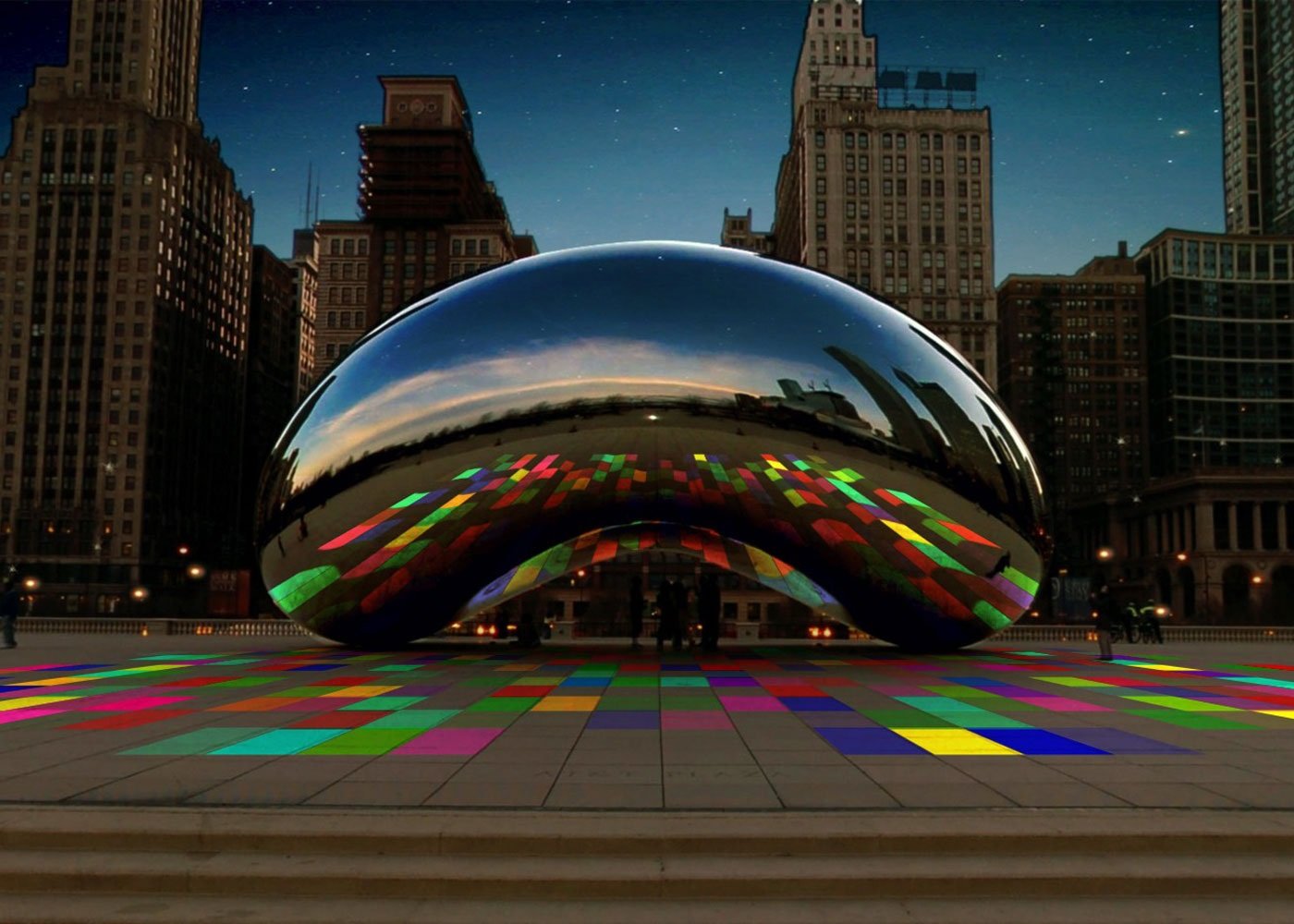
Source: Millenniumparkfoundation
- Crown Fountain: Consisting of two 50-foot glass brick towers that display digital videos of Chicagoans' faces, this interactive fountain is especially popular during the summer months. Visitors can cool off in the spouting water while enjoying the artistic display.
- Jay Pritzker Pavilion: Designed by the renowned architect Frank Gehry, it is an architectural marvel with a distinctive design and state-of-the-art acoustics that make it a must-see destination for music lovers and architecture enthusiasts alike.
While exploring the area, be sure to visit the nearby Museum Campus, which is home to several world-class institutions, including the Field Museum, Shedd Aquarium, Adler Planetarium, and Soldier Field.
Please note that motorized vehicles, including electric scooters, are generally not allowed within Millennium Park. You may need to dismount and push your scooter while exploring this area to comply with park regulations.
Lincoln Park
Along the Lakefront trail
Lincoln Park is an expansive green space situated along the lakefront, just north of downtown Chicago. One of its most notable features is the Lincoln Park Zoo, one of the oldest zoos in the United States. The zoo offers free admission and hosts a diverse collection of animals worldwide.
Another highlight is the Lincoln Park Conservatory, a large greenhouse filled with tropical plants and flowers. The Chicago History Museum, located at the south end of Lincoln Park, offers exhibits on Chicago's history and cultural heritage. Throughout the park, visitors can admire statues of prominent figures such as Abraham Lincoln and Ulysses S. Grant. One particularly striking feature is the Honey Comb, an innovative design created by architect Jeanne Gang.
Nearby are North Avenue Beach and Fullerton Beach, both popular spots along Lake Michigan. The park is also home to serene lagoons, numerous ponds, and gardens and provides access to various recreational facilities, sports fields, and picnic areas.
The 606 (Bloomingdale Trail)
The 606, also known as the Bloomingdale Trail, is an elevated greenway built on a former railroad line. This 2.7-mile-long trail runs through the heart of Chicago's northwest side neighborhoods, including Logan Square, Humboldt Park, and Bucktown. The trail offers unique urban views, public art installations, green spaces, colorful murals, and local shops along the route. It's very well-maintained, clean, and equipped with lots of entrances and security cameras at various spots.
The 606 is an ideal spot for scooter rides during weekdays and early mornings on weekends. However, it's important to note that the trail can become extremely crowded between 11 AM and 7 PM on weekends, with bikers, runners, hikers, and walkers all vying for space.
You will need to push your scooter through this trail, as all motorized vehicles are not permitted.
Other notable areas for scenic electric scooter rides include:
Navy Pier Park: The park's main attraction is the iconic 200-foot Ferris wheel, which offers breathtaking views of the Chicago skyline and Lake Michigan. Navy Pier also hosts numerous seasonal events, boat tours, theaters, shops, and restaurants. Navy Pier is easily accessible from the Lakefront Trail, making it a convenient stop for those scooting along the lakefront.
Promontory Point: Known as "The Point," this area is part of Burnham Park and offers panoramic views of Lake Michigan and the Chicago skyline. It's particularly known for its stunning sunrise and sunset views over the lake. The point is surrounded by a distinctive limestone revetment, creating a unique waterfront promenade.
Promontory Point is directly along the Lakefront Trail, making it easily accessible for electric scooter riders.
Conclusion: How to ensure a safe ride on Chicago's streets
Chicago has a lot to offer regarding places you can visit on your electric scooter and lanes you can use safely. Just follow the rules set by the city, and you're off to a good start. Ride within the stated limits, avoid riding on sidewalks and other restricted areas, and stick to bike lanes to improve your safety and that of others.
A little bit of defensive riding can go a long way. Stay aware of your surroundings and anticipate traffic, assuming other road users haven’t seen you. The bike lanes are properly marked, but some might not be well-maintained. Be on the lookout for potholes; there are plenty on the lanes, and if you don't pay attention, you could definitely wipe out.
Prepare for the unexpected. Wear a helmet, preferably a full-face one if possible—it might seem like overkill, but it could save your life if you get knocked off your scooter or hit by a car. Gloves with scaphoid protection are also a good idea, as they can prevent hand fractures and their associated complications, which are among the most common injuries sustained on scooters and electric bikes. Additionally, consider wearing knee and elbow guards for added protection.
Remember, winter riding is sketchy. If the roads are wet or over-salted, the chances of a wipeout or a fall increase due to the slippery nature of the surfaces, so it's better to store your scooter during these seasons. Riding in such conditions also increases the risk of damaging your electric scooter's electrical components, which are sensitive to water and cold, so it's not worth the risk.
Lastly, always plan your journey beforehand, checking for bike lane availability and keeping off trails that are not meant to be used by scooters. Although Chicago has a lot of bike lanes, a ranking by People for Bikes placed the city near dead last among big cities for bikeability. The city ranked low for its bike lane accessibility to other transit hubs, amenities, and connecting to other neighborhoods, so put some thought into your route planning to ensure a safe and enjoyable ride.

Stay current with the latest U.S. electric scooter laws in our 2025 guide. Updated annually since our first comprehensive guide, ensuring you have the most recent state and city regulations to ride responsibly”

The Slack Core 920R is currently the fastest electric scooter in 2025 that you can purchase without the need for pre-order.

Our selection of the best electric scooters 2025 spans the fastest e-scooters to the most portable ones, the ones designed for city riding and off-road, the best scooters for rain, budget electric scooters for students, and more powerful ones for skilled riders.

The Unagi Voyager is the best lightweight electric scooter for adults and teenagers. It is the ultraportable sequel to its predecessor, the Unagi Model One Classic.

If you're wondering whether an electric scooter with a seat is right for you, this is a detailed article that would suit your need.

Understand which personal electric vehicle is best, the choice between an electric bike or electric scooter might already be made for you by some critical factors, including portability and storage capacity.

In the U.S., most states don't require a license. For those that do, they usually just ask for a regular driver's license or a learner's permit.

Yes, you can bring an electric scooter on a plane, but it needs to have a lithium battery smaller than 100 watt-hours, which most don't.

Manufacturers advise against riding electric scooters in the rain. The main reasons are: water can fry the electronics, make the ride dangerous, and void your warranty.

The basis and the premise of my work is that we either operate out of love or we operate out of fear...Time is currency. The coolest thing about the scooters is that it's really quick, and it goes uphill. From there, traveling more efficiently and having a good time doing it--I think that's the most important thing.

Cynthia Leu has a full plate. A tech worker by day, Cynthia spends her off time balancing the parallel lives of a powerlifter, entrepreneur, mental health advocate, and more. Riding Unagi helps this USMC veteran cut down on everyday…

https://www.youtube.com/watch?v=7m2hVBE62LY Rasheed Muhammad is sick of Los Angeles traffic. In order to preserve his sanity, Rasheed has traded his everyday driving habit for the portable and beautiful Unagi Model One. It’s an essential accessory for navigating LA streets -- and…

Rich Lee, Co-Founder of San Francisco’s SPRO Coffee Lab, wants to share his love for coffee with the world. He depends on riding Unagi to avoid the hassle of navigating the parking crunch in the booming Mission Bay neighborhood.…














